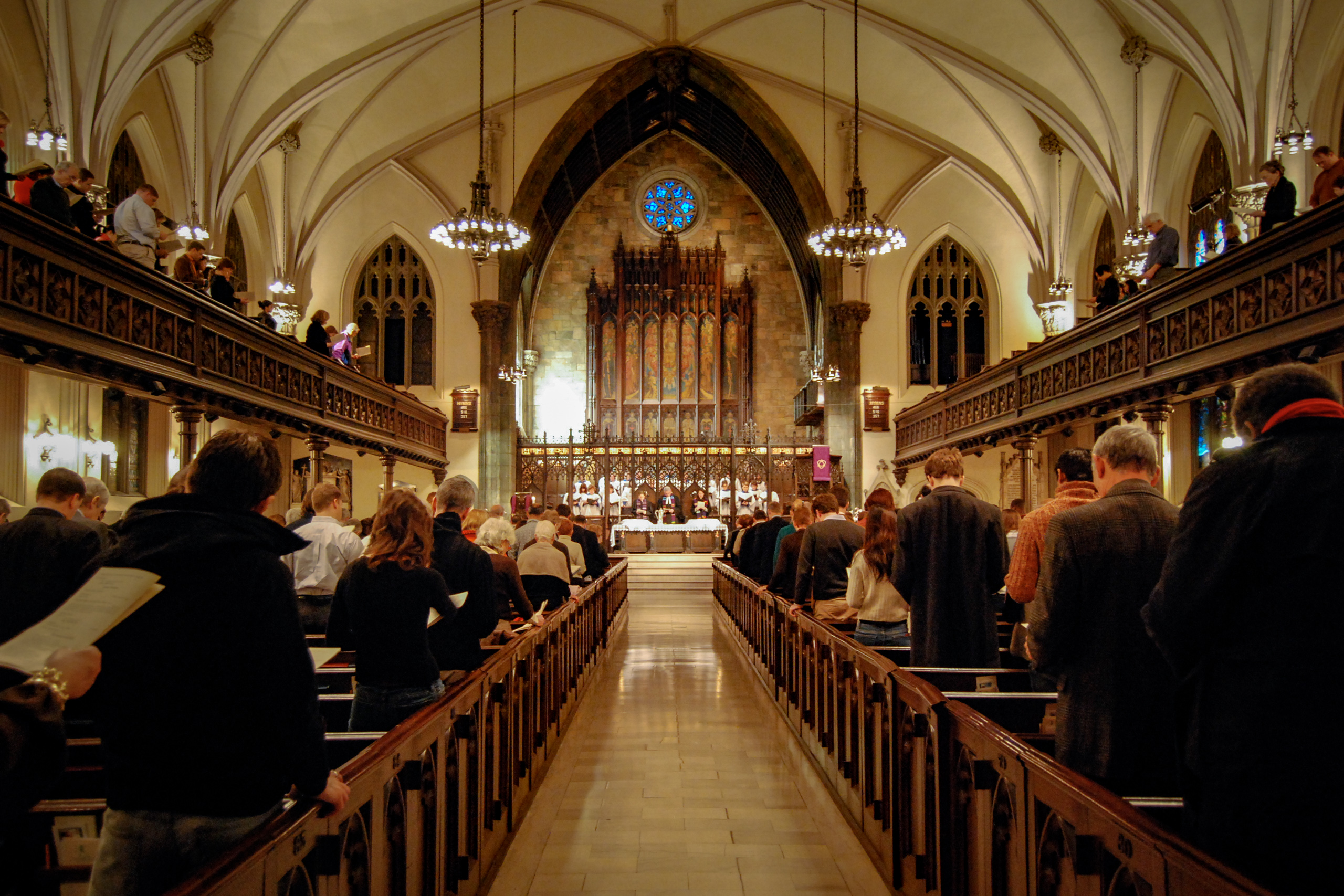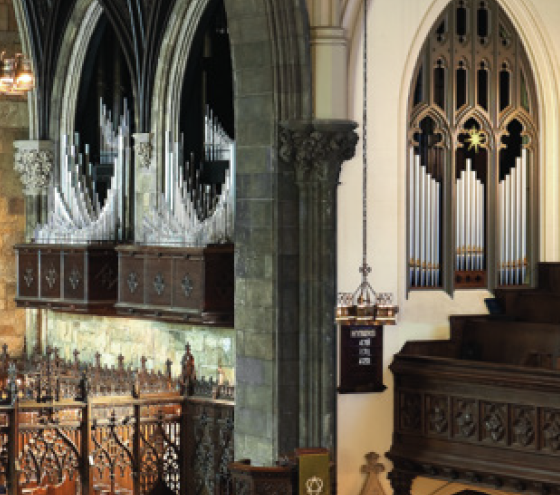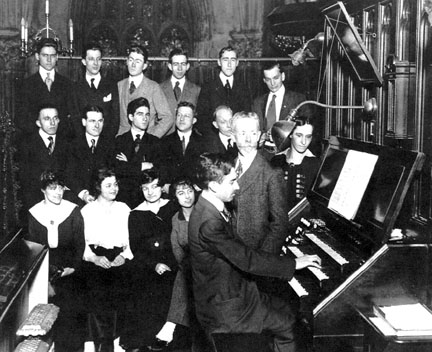Drawing on a rich tradition, our music program has been recognized as one of the finest in New York City.
Our Music Program
The First Church Adult Choir is a strong and integral part of the spiritual life at First Church. Under the direction of Michael Shake, our Director of Music, the excellent choral ensemble is comprised of both professional and volunteer singers. The weekly commitment and spiritual devotion of each member to singing God’s praises are the foundation of this ensemble.
Repertoire includes a broad range of music, from Gregorian Chant and Plainsong to Renaissance motets and the major oratorios and mass settings, to 21st-century compositions, including commissioned works. Twice a year, Vesper Services of Music with full orchestra are presented, which include major choral works, such as Bach’s B Minor Mass, Handel’s Messiah, Mozart’s Requiem, and Poulenc’s Gloria. Many of our choir are heard in major concert halls throughout the world, including both concert and opera repertoire.
EXPERIENCE THE BEAUTY OF HOLINESS
Listen to Choral Anthems sung in worship
Our Recordings
The Choir and Soloists of First Church have released a collection of recordings. From spirituals to Southern folk melodies, Christmas favorites, and albums spotlighting the range and power of the organ, there is something to delight all music lovers.
Click on each album to learn more.
AIN’T GOT TIME TO DIE
Songs of the American Spirit
This all-American program of spirituals and Southern folk melodies presents the very best that the American religious experience has to offer. The First Church Choir is conducted by Dr. William Entriken, Organist and Choirmaster. Soloists and musicians are Ellen Goff Entriken, soprano; Cheryl Zilinyi, mezzo-soprano; David Fox, tenor; John Shelhart, bass-baritone; James Bassi, piano; Walter Hilse, organ.
To make an online purchase or to purchase physical CDs, please contact the church at (212) 675-6150 or [email protected].
SONGS OF OUR SAVIOR’S BIRTH
A Festival of Christmas Music
The music of Christmas has become a particularly beloved part of First Church’s music traditions. On this recording, the First Church Choir, under the direction of Dr. William Entriken, Organist and Choirmaster, sings a selection of the carols, folksongs, and anthems the choir performs every year at the Candlelight Carol Service on the evening of the Sunday before Christmas. Soloists and musicians are Ellen Goff Entriken, soprano; Cheryl Zilinyi, mezzo-soprano; David Fox, tenor; Eric Johnson, bass; Susan Jolles, harp; Walter Hilse, organ. Fifteen tracks in all.
To make an online purchase or to purchase physical CDs, please contact the church at (212) 675-6150 or [email protected].
GRACE AND GOD OF GLORY
Songs of a City Church (2015)
In 2015, the choir and soloists released this album commemorating the 300th anniversary of First Presbyterian Church. The choral album features the congregation and choir singing the hymn “God of Grace and God of Glory” accompanied by brass quartet and organ. The choir sings many anthems that are favorites of this congregation, including “Draw Us in the Spirit’s Tether,” the Christmas anthem “What is This Fragrance” by former organist John Huston, and the moving spiritual “Ezekiel Saw the Wheel.” A 20-page booklet accompanies the album, featuring a history of the music at First Presbyterian, historic photos, and anthem texts. Get your copy of this collection of sacred music today.
A SMALL WONDER
Music from Alexander Chapel
No room for a pipe organ! The jewel-box Tudor room that is Alexander Chapel comfortably seats about 50 people, its gilded plaster ceiling, oak-paneled walls, and slate floor providing a visual feast. This album celebrates the perfect union of room, acoustical space and organ. The delightful program includes works by Lübeck, Bach, L.-N. Clérambault, Handel and others. Booklet contains detailed program notes and organ specifications. For further information about this unique artistic instrument, please visit www.glucknewyork.com.
To make an online purchase or to purchase physical CDs, please contact the church at (212) 675-6150 or [email protected].
FOUR CENTURIES OF COLOR
This exciting recording of the sanctuary organ shows the full dynamic range and color of this outstanding instrument (approximately 5,000 pipes). The full program features compositions from the 17th-century Golden Age of organ music to colorful and bold works of the 20th century and includes works by Buxtehude, Bach, Schumann, and Vierne. Of particular interest is the glorious sound of the Tuba Major, a commanding trumpet stop and addition to the instrument, which is featured in C. S. Lang’s Tuba Tune.
“Four Centuries of Color” debuted at the American Guild of Organists National Convention in Washington, D.C., and has been featured on “Pipe Dreams,” a nationally syndicated radio program heard on WQXR. This album joins the previously issued recording of the Chapel organ, “A Small Wonder, Music from the Alexander Chapel.” Both recordings have been made possible by Glück Pipe Organs, builder of the organs at First Presbyterian (glucknewyork.com).
To make an online purchase or to purchase physical CDs, please contact the church at (212) 675-6150 or [email protected].
Music History
Music at First Church has moved from cause for discord to source of harmony and strength. Today’s worshipers might argue with the old traditionalists: One of the “important things heard in the house of God” is the sound of music.
Expand All | Collapse All
In the early years of First Church, music sometimes provided more discord than harmony for the worshipers. It was an inauspicious birth for the exhilarating music that fills First Church today.
Until the mid-18th century, the sole music permitted was the singing of psalms a cappella from an “Old Scots” psalm book. In 1748, when the church’s liberal trustees voted to substitute Isaac Watts’s hymnal (including such familiar hymns as “O God, Our Help in Ages Past” and “Joy to the World”), traditionalists in the congregation were outraged. The argument was decided in favor of the Watts version, with a caution against the singing of anthems on The Lord’s Day, which might distract worshipers from “the important things heard in the house of God.”
A group of disappointed traditionalists withdrew and formed their own congregation on Cedar Street which grew into Fifth Avenue Presbyterian. No wonder music remained a mere footnote in the annals of First Presbyterian for nearly a century!
By the time the church moved into its current building in 1846, hymns were somewhat more welcome and music leadership rested with a quartet of singers who relied on a pitch pipe because no musical instruments were permitted in the sanctuary.
In 1855, the liberal movers again began nipping at the heels of the traditionalists. Trustees proposed installing a pipe organ, thinking it might “attract young people and strangers to the services.” But James Lenox, scion of the influential family of Lenox Hill, leading elder and largest financial contributor to the church, had no use for such sinister innovations. So it was not until 1886, six years after Lenox’s death, that an organ was finally installed.
William C. Carl became the church’s first organist in 1892. He quickly instituted a full music program and recruited a choir to back a professional quartet. Carl’s Motet Choir, recitals, and Sunday evening oratorios drew audiences of more than a thousand.
A succession of distinguished musicians followed William Carl. First was Willard Nevins, a music columnist for the New York World Telegram, who took over after Carl’s death in 1936 and remained until 1957. John Huston, formerly of Holy Trinity in Brooklyn and Temple Emanu-El, was at First Church from 1957 until 1975. He was followed by Robert Baker, former dean of Union Seminary’s School of Sacred Music and Professor of Organ at Yale. On Dr. Baker’s retirement in 1988, a former student of his, Dr. William F. Entriken, left neighboring St. Luke’s to become First Church’s organist and choirmaster. Dr. Entriken retired after thirty years of service in 2018 and holds the titled of Organist and Choirmaster Emeritus. Our new Director of Music and Organist, Michael Shake, was welcomed in September 2019.
Music at First Church has moved from cause for discord to source of harmony and strength. Today’s worshipers might argue with the old traditionalists: One of the “important things heard in the house of God” is the sound of music.
As early as 1855, the Session wanted to install a pipe organ to attract younger worshipers, but Elder James Lenox, who controlled the church’s finances, opposed “the sinister influences of such innovations.” After Lenox’s death, however, the way was opened, and in 1887 the first pipe organ was installed. Located in the rear of the sanctuary, this was a large, three-manual instrument built by the noted organ builder Frank Roosevelt (Opus 264). So successful was this innovation that by 1898 a second organ was purchased for the lecture room. In 1892, Dr. William C. Carl was appointed the church’s first organist and choirmaster. Dr. Carl, a former student of Alexandre Guilmant, and Dr. Howard Duffield, minister of First Church, founded the Guilmant Organ School, one of the first American schools devoted exclusively to the training of organists and choirmasters. The Guilmant Organ School at First Church attracted organ students from all parts of the country. In 1919, the Roosevelt organ was replaced by a Skinner organ (Opus 293). Skinner rebuilt this instrument in 1929 (Opus 293A). The present instrument was built by Austin Organs (Opus 2408) in 1964. It is a IV/81 with five divisions: Great, Swell, Choir, Solo, and Pedal. (The sixth division, a Skinner Echo division, has since been removed.) Of particular note are the solo orchestral stops and large Pedal open wood stop from the Skinner and Roosevelt organs. In the fall of 1995, Austin Organs added a new Great principal chorus to the instrument and tonally refinished a large portion of the instrument. Two years later, due to a construction error, the sanctuary and the organ were covered with 100-year-old plaster dust. The entire organ was removed from the chambers and cleaned by the organ firm Glück New York. At this time Sebastian M. Glück did further tonal work, creating a warmer and broader sound.
To view complete information about this landmark instrument and the specifications, please click here.
CHAPEL ORGAN
In 2004, The Alexander Chapel was graced by the dedication of a marvelous new pipe organ.
Since the Alexander Chapel was built for the 1892 South Wing of First Presbyterian Church, the dream of a pipe organ remained elusive. In recent decades, an electronic substitute went virtually unused, and the situation looked bleak.
Former Clerk of Session, Mrs. Betty Jones, thought otherwise, and in memory of her late husband Rees, donated a pipe organ to realize his lifelong dream. Four American organbuilders were invited to bid on the project by Dr. Willliam F. Entriken, Organist and Choirmaster, and Glück was chosen for the visual elegance, historically inspired stoplist, and compact engineering of their design. With its installation, the Alexander Chapel has taken on new life, being used for evening Vespers, life cycle events, teaching, and practice.
While gracefully framing the stained glass window, the instrument makes no physical intrusion or attachment to the physical fabric of this historic room. The jewel-box Tudor chapel comfortably seats about sixty people, and features low ceilings and limited floor space. Its gilded ceiling, oak-paneled walls, and slate floor provide a live and telling acoustic despite the small space.
The pipework is fashioned of red oak, poplar, walnut, planed 50% tin, and flamed copper for the basses of the 8’ Dulciana which flank the main soundboard. The 16’ Double Dulciana utilizes free reeds in the manner of a 19th century French harmonium, with a seamless transition to the bottom octave. An unusual tonal feature is the 4/5’ Choral Bass, which when drawn with the 4’ and 2’ flutes, provides a horn-like, reedy cantus firmus voice. The organ’s pipework is unenclosed, but the keydesk features a balanced expression pedal for practice purposes.
For more information from the Glück New York website, click here.
The Guilmant Organ School was one of the first accredited schools in America devoted to teaching organists and church musicians. Learn about the history of this pioneering era.
Immediately after his appointment in March of 1892, Carl began a series of organ recitals that were so successful that the church was filled to capacity at most concerts and the police had to control the crowds on Fifth Avenue.
As more churches were built in the latter part of the 19th century, the number of organ builders in America increased to meet the need for musical instruments, and many ne instruments like the Roosevelt Organ at First Church were built. However, there was a lack of well-trained organists to play these new, impressive looking and sounding instruments. While recently established music conservatories and schools in America taught some organ, the serious student traveled to France and Germany for training. William C. Carl, like many American students, went to Paris to study with Alexandre Guilmant and the two became life-long friends. Guilmant (1837-1911) came from a long line of organists and was not only known as a great teacher, but also as an organ virtuoso and church musician.
Guilmant toured America three times, performing in major churches and concert halls, and played forty recitals at the St. Louis 1904 Exposition. Since the American public had never heard or seen organ playing like this, Guilmant immediately became a celebrity. He performed several times at First Presbyterian, and Walter Damrosch referred to him as “a wizard of the organ.” When he played a passage with his feet alone, the audience was wild with excitement. Guilmant was organist at La Trinité, Paris, and taught at the Paris Conservatory. In 1894, he founded, along with other colleagues, the Schola Cantorum in Paris, a school for training church musicians. Guilmant’s stylized playing is best described as having a singing, clean, legato line. His method of teaching was revered, and he paid close attention not only to organ playing technique but to the poetry of the music as well. Guilmant was a prolific composer, and his wife ran the family publishing business. In 1898, during Guilmant’s second American tour, Carl and Guilmant decided to open a school for organ instruction in New York based on the master’s method of teaching.
In 1899, Dr. Duffield invited the Guilmant Organ School to open at First Presbyterian Church with the magnificent Roosevelt Organ as the centerpiece for lessons and recitals. The first class was held on October 9, 1899, in the chapel.
Guilmant was the President, Carl was the Director and Instructor of Organ, and Dr. Duffield was the Chaplain and Instructor in Theology. The following excerpt from the initial announcement gives a clear idea of the purposes of the school: William C. Carl having been authorized by Alexandre Guilmant to open an organ school under his patronage begs to announce the Guilmant Organ School, in which the method as set forth by the great French organist will be taught. Since the phenomenal success of M. Guilmant in America, a new impetus has been given to the organ as a solo instrument and in its relation to the church service. Organists in all parts of the country are giving more attention to its study and in the preparation of their work. Organ concerts are in demand with a growing success. Church committees are exacting a higher degree of ability from their organists and the press is giving it attention. These facts have demonstrated to Mr. Carl the necessity of such a school, where the organist will receive a practical training for the church service and a more thorough understanding of the ecclesiastical music.
The Guilmant Organ School at First Presbyterian Church quickly became one of the leading institutions for the study of organ and church music in America.
The school awarded a diploma after two years of study, and courses were offered in private organ instruction, general music studies, and theology. A silver and gold medal designed by Tiffany was awarded to the graduate of each class with top honors. In 1915, six scholarships were established, so that students from across America could study at the school. Through the years, Carl and the Guilmant Organ School gained international recognition. The French government bestowed on him the Officer de l’Instruction Publique, and he was made a Chevalier of the Legion of Honor in recognition for his work in promoting the works of Guilmant and other French composers. New York University conferred on him an honorary Music Doctorate Degree. The 25th anniversary of the Guilmant School was celebrated in 1924. One hundred and fifty students had graduated from the school, and 26 of them were in responsible positions in the greater New York area. To celebrate Carl’s 40th anniversary as Organist at First Church in 1932, the church installed a bronze plaque in the choir. In 1935, Carl was granted a leave of absence from his duties at the school for health reasons, and Willard Irving Nevins, Carl’s first student and associate, became director of the school. On December 8, 1936, Carl died and in January 1937, Mr. Nevins was appointed Organist and Choirmaster of First Church. Under Mr. Nevins, the school continued its fine service in the field of church music.
With a view toward solidifying the position of the school in the education scene, Mr. Nevins arranged for incorporation of the institution, in 1940, under the laws of the State of New York. The school was later approved under the regulations of the University of the State of New York, in order that colleges could give credit for work done in the school. In 1956, Willard Nevins retired as Organist and Choirmaster at First Church, but remained director of the school until his death in 1962. On January 18, 1960, the school celebrated its 60th anniversary, and a gala dinner was held in the newly built Church House (now the Mellin-Macnab Church House). In March 1963, Dr. George Markey, Organist and Choirmaster of Madison Avenue Presbyterian Church, became the third director. At this time, the school left First Church. Dr. Markey’s dream was to recast and update the school in order to compete with major American music conservatories. The school continued to receive much attention when, in 1965, the Guilmant Organ Festival was held on the new Aeolian-Skinner Organ in Philharmonic Hall, Lincoln Center. However, after leaving First Church, the school never found a permanent home, and closed in the early 1970s. The Guilmant Organ School was an institution with high standards that successfully trained young organists to go forth and serve congregations throughout America. One hundred years ago, the congregation of First Church made a commitment to the educational development of church musicians in America, and many students learned to play and refine the art of organ performance in the church’s sanctuary. Today, graduates of the school speak fondly of the time they spent studying at the school and First Church. In the 21st century, it is important to remember and give thanks for the strong witness of the forebears of this congregation, a congregation that began over 300 years ago.
Family Music Ministries
When children sing scripture, they remember it for a lifetime.
The Family Music Ministries at First Presbyterian engages our children and youth in making a joyful noise to God. Children of all ages are encouraged to explore and befriend their voices as they gain the skills to be worship leaders in the congregation singing at special events and services throughout the year. Emphasis is placed on music making as an act of praise and worship that extends from our gratitude for all of God’s gifts. Singers learn theologically rich pieces from around the world that reinforce their skills, as well as familiarize themselves with the great hymns of the church.
The music program works in partnership with the Church school September through May. Children are placed in age-appropriate groups.






































